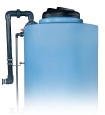As winter approaches, you may often hear the important chemical Magnesium Chloride discussed. Magnesium Chloride is commonly used in different de-icing techniques across the northern parts of the country. But with so many people using it, it’s important that we discuss the proper storage solution.
Topics:
Chemicals
Chlorine dioxide is an NSF/ANSI approved chemical at 38% or less concentration for Poly Processing tank systems. A neutral chlorine compound, chlorine dioxide is a strong disinfectant that differs in chemical structure and behavior compared to elementary chlorine. It is also highly soluble in water, approximately 10 times more soluble than chlorine. Even in it’s liquid state, chlorine dioxide remains a dissolved gas in solutions, requiring us to be very careful when storing the chemical, no matter it’s concentration.
Topics:
Chemicals
Poly Processing Company works with leading universities to develop engineered polymer systems that will perform above and beyond any standard “off the shelf” polyethylene in harsh, oxidizing environments. One of these engineered polymer systems is the OR-1000 system. Poly Processing Company had the OR-1000 system tested by a leading university for its ability to withstand Environmental Stress Cracking.
Sodium hypochlorite (NaOCl) is an NSF/ANSI 61 approved chemical at a 15% concentration or less for Poly Processing’s tank systems.
When assembling and installing your chemical storage tank system, there are several steps to the process. To help extend the longevity of the tank, Poly Processing put together a checklist for your startup.
Topics:
Installation and Field Service
Powder coating is a dry finishing process that uses powder to create a high-quality finish on surfaces. The coating is applied with a combination of electrostatic charge and heat curing process. Powder coatings are available in thousands of colors, and are as versatile as liquid paint, while offering some advantages over the traditional painting process.
Topics:
Fittings and Accessories,
Tank Design and Materials
Maintaining the proper temperature of a chemical is often critical to safe storage. For example, sodium hydroxide, at a 50% concentration will start to crystalize at or below temperatures of 60 degrees Fahrenheit. With polyethylene tanks, heat tracing and insulation is available to maintain the specific temperature of the chemical being stored. Heating pads and foam insulation combine to maintain the chemical temperature even when the tank is exposed to lower ambient temperatures.
Topics:
Fittings and Accessories
Poly Processing is proud to offer the newest Chemical Storage Tank Systems and Accessories, Product and Resource Guide. It is available at Polyprocessing.com and can be downloaded at the end of this blog. At Poly Processing Company, we make it a priority to ensure that you have all of the information needed to build a safe, reliable chemical storage system. That's why our complete Chemical Storage Tank Systems and Accessories, Product and Resource Guide is more than just a list of everything we offer. We've developed a resource guide that is educational and a valuable resource for building a Poly Processing tank system that's right for your specific application.
Topics:
Value Added,
News and Customer Stories
At Poly Processing Company, we have a number of customers who have asked about the use of load cells. Load cells are used to weigh chemical storage tanks through an independent measuring system—no level measurement devices are placed in the tank itself. This allows one scale to be used to weigh a variety of tanks or chemicals without requiring anything to be installed on the tank itself.
Topics:
Value Added
Poly Processing Company prides itself in its people, products, and manufacturing plants. We are always trying to find ways to bring the PPC experience to our customers so they can get a first hand look at our company. We are excited to offer the new "Poly Processing Company Introduction Video" to give you a glimpse into our manufacturing facilities, and the people that deliver on the promise of serving our customers needs, demands, and expectations.
Topics:
Value Added



